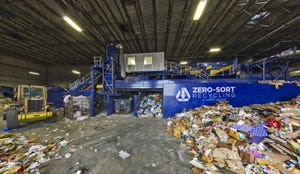A Valuable End-Game
January 1, 2006
Eddy Dean Smith
THE U.S. ARMY, known for its military precision, recently found it could benefit from a little fluff. Thanks to the Army Engineer Research and Development Center's Construction Engineering Research Laboratory (ERDC-CERL) and the National Defense Center for Environmental Excellence (NDCEE) Program, the Army has been creating a soil amendment called “Fluff” and lumber material from its municipal solid waste (MSW).
The Army generates an average of 3 million tons of waste from bases at an estimated annual disposal cost exceeding $140 million. MSW represents a large and costly portion of an installation's waste stream. So, the Army was interested in helping bases to divert significant amounts of their MSW volumes from landfills.
One emerging technology that has turned common household garbage into a nutrient-rich fluffy material that can be used as a soil amendment or a composite plastic-like lumber is an MSW conversion system developed by Bouldin & Lawson LLC (B&L), a McMinnville, Tenn.-based greenhouse and nursery equipment manufacturer.
The conversion process has three phases: size reduction of raw waste; “cooking” of reduced waste materials; and conversion of materials into end products.
Waste Reduction
The process begins at a raw waste pile, where material handlers separate batteries, carpet, tires and other non-MSW items that might cause harm to equipment or personnel. Material handlers then load the segregated waste into two shredders for size reduction. The reduced materials fall onto a conveyor system equipped with magnet rollers to recover ferrous metals. The conveyor then transports the reduced materials into a large, high-speed rotary drum grinder, which pulverizes the materials into pulp.
Creative Cooking
The pulverized materials then are ready for “cooking” as they go into the hydrolyzer, the heart of the waste conversion process. The hydrolyzer is a horizontal, jacketed vessel that uses high-pressure, high-temperature steam to break down and sanitize the waste materials. A ram auger then presses the cooked materials — which by that point have become a coarse cellulose pulp mix of organics and fines, such as bits of metal, aggregate, and glass — into a horizontal furnace dryer.
End Products
The dried coarse pulp exiting the furnace dryer can be collected and extruded into products similar to composite plastic lumber. B&L has extruded the pulp into a variety of products such as landscaping timbers and tongue-and-groove boards.
Alternatively, a two-step separation process removes the fines and converts the pulp into a cottony material, called Fluff. B&L states that the Fluff may be useful as soil amendment because of its organic base and relatively high nitrogen content.
To date, the Army has tested and demonstrated the system at Ft. Campbell, Ky., and Ft. Benning, Ga. Demonstrations proved the composite planks have can be used as an alternative, low-grade product for agricultural, industrial, civil engineering and residential industries. Moreover, recent studies by Auburn University suggest that the Fluff can supplement traditional horticulture substrates — specifically pine bark and peat moss.
The Army believes the technology requires additional engineering attention and that the end-products need to be evaluated to ensure the Fluff's benignancy and ability to enhance composite plank properties. However, based on the test demonstrations, the Army believes the technology could offer immediate MSW solutions to pressing environmental issues affecting military installations — and possibly beyond.
Dr. Eddy Dean Smith of the U.S. Army Engineer Research and Development Center Construction Engineering Research Laboratory, and Paolo Legaspi of the National Defense Center for Environmental Excellence.
Acknowledgment:
Funding for the project was provided by the National Defense Center for Environmental Excellence, which is operated under contract by Concurrent Technologies Corp. The views, opinions and/or findings mentioned are those of the authors and should not be construed as an official Department of the Army position, policy, or decision, unless so designated by other official documentation.
You May Also Like


